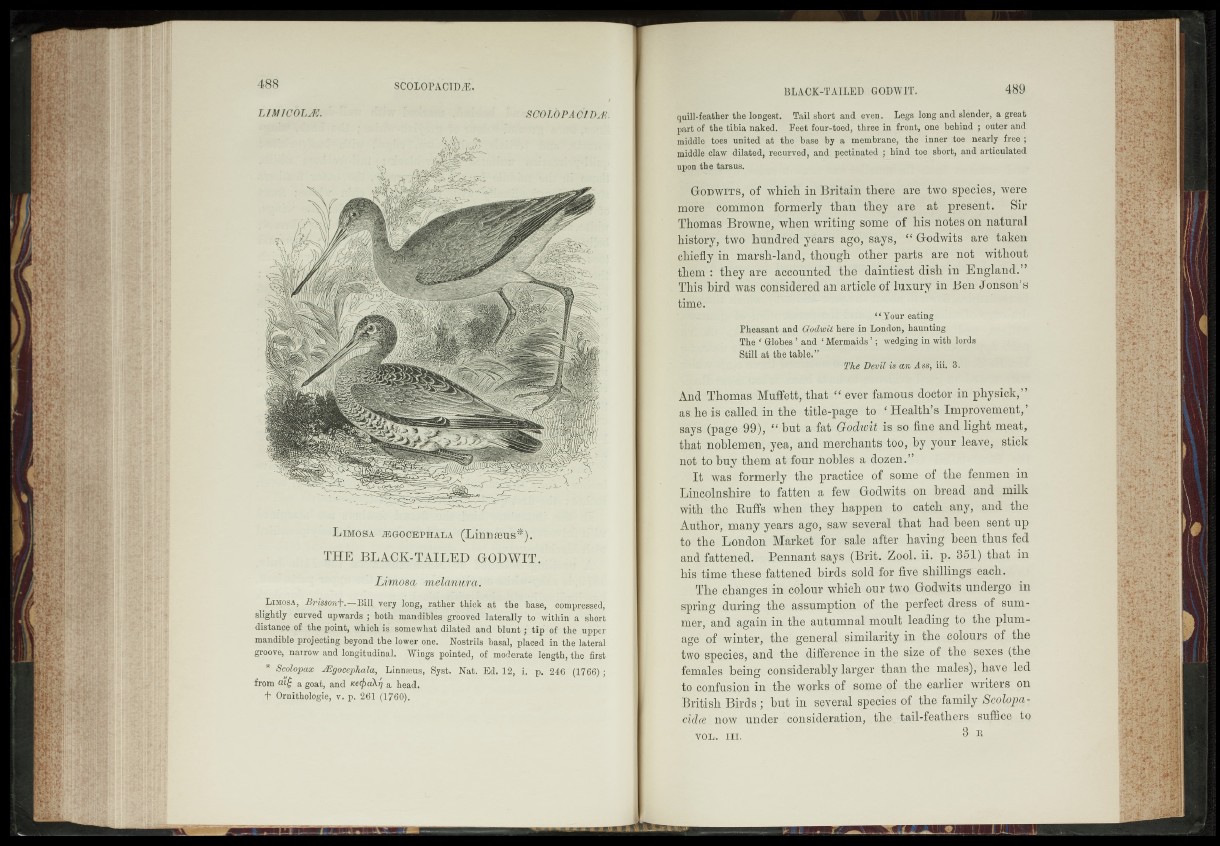
LIMIOÖLJS.
S C O lO P A C lD lE . quill-feather the longest. Tail, ?hoit and even. Legs lqng and slender,» great
L imosa ' ^ gÖce-phaïIa-’'{L in b a h i«% .. ^
THE BL^gK-TAILEH idODWIT.
-Evrnosq ïmeiïamMv6tf$&
LxstpSA, £ ^ s o ,i^ ,—=Siï!^Y.eiy long, rathèr t^ ek ai" the base,' compressed,
slightly curved upwards j both mandrble.S"groovèd "laterally to^withïn' a short
distanpe p£ the point, which'ig; §oi&ewbat dila.ipd, and blunt rjtip of the {upper
mandible projecting beyond the lower one,;ThTos,trils basal, placed the lateral
groove, narrow and longitudinal. Wiogs pointed, of moderate length, the first
* Scologax jEgocephala, Linnaeus, Syst. JNat. Ed. l ? , i . p. ,21b (17Cj5) ;
from a?£ a goat, and Ketfrakr) a head.
+ Ornithologie, v. p.
part of the tibia naked. Feet four-toed, three in front, one behind ; outer and
middle toes united at the base by a membrane, the inner toe nearly free ;
middle claw dilated, recurved, and pectinated ;_hjnd toe short, and. articulated
upon the tarsus.
é'DDWïTS, of which in Britain there are two species, were
more ^comnïörf - formerly than" they are at present! ' Sir
Thomas Browne, when writing some of his Dotes on natural
history, two hundred years ago, says, ££ Godwits are taken
chiefly in marsh-land, though other parts are not without
them: théy af I? Ifefeounted thé' daintiest dish in England.”
This bird wAsiöuDsidered an article óf luxury in Ben* Johsön’s
time.
> , M Your-eating'
Pheasant and (fyckjbit here in London, haunting :
The ‘ Globes ’ and g Mermaids ’ ; wedging iuwith,l<^ds^
' 1 Stijj at .the tablp;”^ d
The Devil* is an A si,' i®s#3.
And Thomas Muiïett, th a k £AeièrTamou,a!;doctox imphysiek,’
as^heil called in th e , tigfe-paga -to.-'Healths Improvement/-
sajlttpagë -99||4£;feuka fat- G-odtoit Jftso fine and, light meat,
that noblemen, yea, and merchants toothy yöur leave^ stick
not to buy them attfour nobles' a- flozjen/?’v
I t was formerly the practice of .sjapiO'-Of. the forten-, in
^BPolushire fatten a few God$nf§<- :0<n „bread and „milk
wth'lthfi Buffs when, É&jÉ happe^ to catch any, -e^d the
Author, many years ago, saw several that had sent up
to-the London Market for sale after hnviug' heen thus fed
and fattened". Pennant says X-3?^i't..'Zojpl..fii. in
fits time, th^Se-jattene2d birds ë°ld for fiye shillings each.
liMhe changes in colour which, our two God-wits undergo* in
spring during .thé: assumption, of the perfect dress of sum?
riaftr, and again in the autumnal moult leading the plum-<
age pf -winter, the general similarity in*thp'.,gplpu$is pf t ^
tsio' species, and the difference' in the si^e of the sexes-(the
fgjnales being>eonsidprablyjarger tjian the. males^,’ have, led
te,confusion in .the works of some^of^the earlier writers on
British Birds; but in several specif pf the family
office now under consideration, the, - tail-feathers suffice to
VOL. TIJ. 3 R